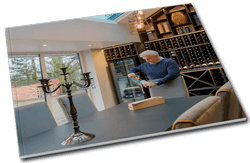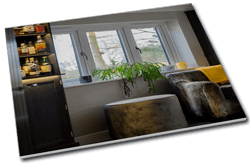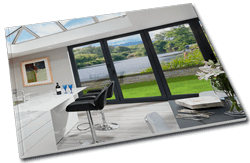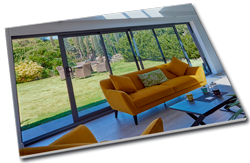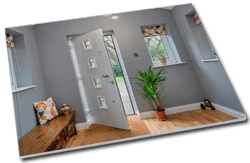Can you tell me about the differences between a conservatory, extension, and orangery?
We’re asked this question a lot and to be honest, things have become so blurred so far as these extensions are concerned that a living space can be pretty much anything you want it to be nowadays. Tradition used to dictate that a conservatory be largely glazed, with a glass roof and glass roof, giving you a beautifully transparent view of the outside and the sky. But along came the tiled roofing system, to better insulate conservatories, with added insulation coming from dwarf walls. You can also include solar control glazing as a further weatherproofing measure to stop a conservatory from ever getting too cold or too hot.
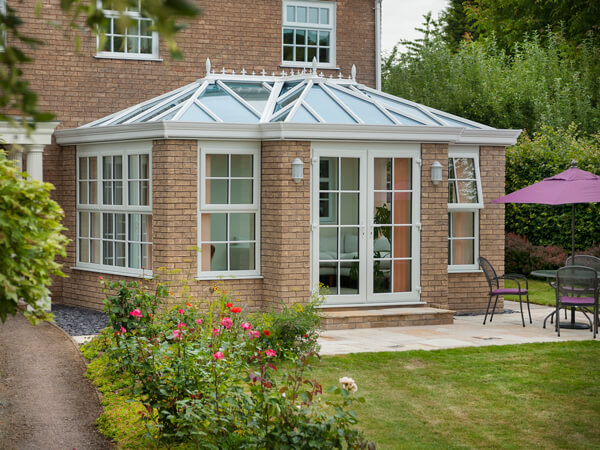
Your typical orangery will have brick or aluminium pillars, making it feel private, warm, and wonderfully luxurious inside. It will also have a pelmet around the roofing system, giving you fantastic insulation within an orangery.
Speaking of the roof, you can have many styles of roof, such as a glass lantern, solid tiled roof, or something that’s a mixture of the two.
If you want an extension that very much looks as though it is an original feature of your house, a home extension will be your best bet. It will have a solid feel and generous amount of brickwork, as well as likely having a solid tiled roof. You can have a hybrid roof though, one that contains full length glass panels and/or Velux windows, to give you excellent ventilation and a wealth of natural light. Extensions get chosen for their year-round useability, as they’re always comfortable enough.
But does it matter what you call them? Plan your chosen living space with the expert help of a Weatherproof advisor.
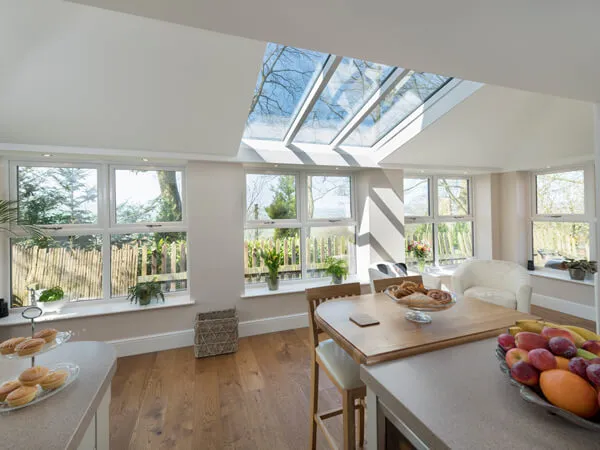
Should I choose a tiled roof or a glass roof?
Make this decision based on a series of factors, including how the room will be used, the direction it will face and the budget you have available. If you would value lots of natural light and a lovely garden, you will be happy to know that solar control glazing is so advanced now, and there are other many glazing options you can consider.
A solid tiled roof is a definite winner if you want a space that you can continuously use in all weathers. This roofing system can incorporate full length glass panels or Velux windows, which will give you a hybrid of a solid and glass roof and their respective benefits.
Our advisors have a firm understanding of these roofs and can help you select the correct covering.
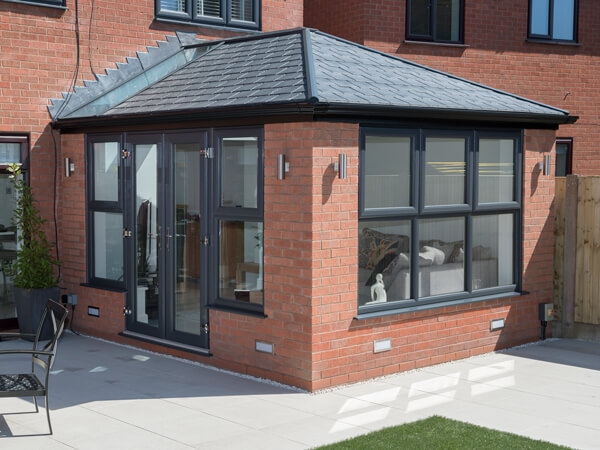
More common questions on Living Spaces
Got a question of some kind about our living spaces? Turn to our advisors for an answer. Here are some of the most common questions they receive from customers.
Will my living space ever overheat or be too cold?
Problems like that will not occur as we build our living spaces with the intention of them being year-round locations. You won’t experience the issue of the space burning up in summer, as would typically happen with an old polycarbonate roofing system. With the inclusion of solar control glazing, the weather will be kept out, so it’s worth requesting it for a tiled roof covering.
Do you manufacture your own roofs?
Weatherproof Windows & Doors is a member of the Conservatory Outlet Network and its sister company, Conservatory Outlet, is a leading manufacturing of roofing systems. The roofs are built in Conservatory Outlet’s very hi-tech manufacturing facility based in Wakefield, West Yorkshire.
The close relationship we have with our manufacturer enables us to keep tabs on our supply chain and ensure that our product standards never slip.
Can you have different roof tiles, so they match my home?
That can be organised, yes, Weatherproof can offer you a range of shingle and slate roof tiles and provide a perfect match for the tiles that are on your house. Various flat roof membranes are available at Weatherproof. More details can be obtained from an advisor.
What are 'A' rated windows?
In accordance with the BFRC Rating Scheme, ‘A’ rated windows are the most energy efficient windows you can buy in the UK. All replacement windows are rated for their energy efficiency like this, and it highlights whether a set of replacement windows comply with UK Building Regulations.
White goods are energy rated in similar fashion e.g., fridges, freezers, washing machines etc. with windows using a traffic-light system from A-E. Always refer to the energy rating of a window to identify the thermal qualities of a window design.
What is solar control glazing?
The clever coating in solar control glazing serves the purpose of preventing too much heat from being transmitted into a space and halting heat loss and draughts. We can tint this glazing in different ways, depending on the amount of light and heat retention you want to achieve. Speak to Weatherproof to find out more about this.
Is it possible to match to my existing bricks?
You can trust in Weatherproof to find the closest possible brick match for your property – before we do anything, you will be shown this to check you are happy. It is important you know that there can be weathering differences between new and existing bricks. If you have difficulty finding a suitable match, the brickwork can be tinted accordingly, but this will incur an extra charge.
Is Building Regulations Approval necessary?
Building Regulations Approval tends to need to be obtained for the extension of a property, however, some forms of extension will be exempt from this. One of Weatherproof’s surveyors will clarify the situation, coming out to your home to assess what is required. If it turns out that Building Regulations Approval will be needed, you can rely on Weatherproof to help you get this organised.
Will planning permission be needed?
It won’t be if the extension or addition can be classified as a Permitted Development, which does away with the need for a planning permission application. These are the conditions that must be met for it to have Permitted Development status:
- The ground area covered by the extension and any other buildings within the boundary of the property, excluding the original house, is not more than half the total area of the property.
- Any part of the extension is not higher than the highest part of the roof of the existing house.
- The eaves of the extension are not higher than the eaves of the existing house.
- Any part of the extension does not extend beyond any wall facing a road if it forms the principal or side elevation of the original house.
- The eaves are no more than 3 metres in height if any part of the extension is within 2 metres of the property boundary.
- The materials used in exterior work, except in the case of a conservatory, are of similar appearance to the existing house.
- An upper floor window on a side elevation within 15 metres of a boundary with another house is obscure glazed; and is non – opening unless the parts which can be opened are more than 1.7 metres above the floor of the room in which the window is installed.
- A side extension does not exceed 4 metres in height or be wider than half the width of the original house.
- In a single storey extension
- the extension does not extend beyond the rear wall of the original house by more than 4 metres for a detached house or 3 metres for any other type of house;
- the height of the extension does not exceed 4 metres;
- no part of the extension is within 3.5 metres of any property boundary with a road opposite the rear wall of the house.
- In an extension with more than one storey
- the extension does not extend beyond the rear wall of the original house by more than 3 metres;
- no part of the extension is within 7 metres of the property boundary opposite the rear wall of the house;
- the roof pitch of the enlargement is as far as practicable the same as that of the original house.
- If you live in a house within a conservation area, World Heritage Site, area of outstanding natural beauty or National Park-
- no part of the exterior of the house is clad with stone, artificial stone, pebbledash, render, timber, plastic or tiles;
- the extension is not more than 1 storey or 4 metres in height;
- no part of the extension extends beyond a principal or side elevation of the original house
How long will it take to construct the living space?
We wouldn’t like to say until we have uncovered if planning permission will be required first and have an idea of what the project will involve. Weatherproof had created a document called ‘What happens next’, which has more information about potential timescales.
What is a test dig?
A test dig gets carried out so that we can check if local ground conditions are suitable for a traditional concrete base and foundation before we begin with the build. If the ground is found to be unsuitable, Weatherproof will suggest an alternative foundation proposal, such as a specialist pile foundation or concrete raft.
What is a cavity tray?
A cavity tray is a series of high level damp proof courses that bridge a wall cavity to direct moisture to the external face of a wall where the extension roof joins the house wall. The job of the cavity tray is to stop the external moisture that penetrates an outer wall from being visible inside the extension.
Need more inspiration? download our brochure
Simply select the brochure(s) you would like to browse, fill in your details, and then click ‘Download’.
Step 1 – Please select the brochure(s) you would like:
Weatherproof customer reviews
Looking to improve your Yorkshire home? Why not have a glance through some recent reviews from customers who chose Weatherproof for their home improvement preoject.
Get in touch online today!
Simply fill in your details and send us your enquiry. A Weatherproof advisor will get back in touch to discuss your enquiry.
